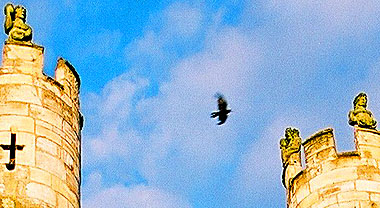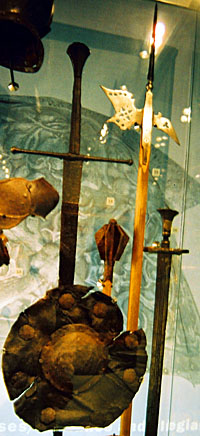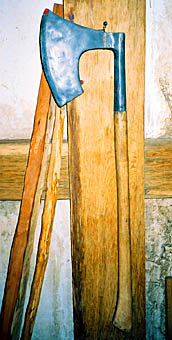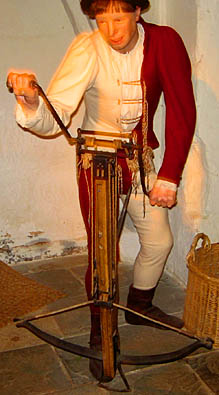
Stone figures atop the Monk Bar gateway at York
appear to hold stones, the most basic of weapons, and be ready to drop
them on the heads of any attackers. The statues, if reasonable
facsimiles of eroded ones they replaced, may have been intended as
a symbolic warning that the citizens were prepared to defend against any
assault.
Photo © S. Alsford
Henry II's Assize of Arms, specifying the type of equipment to be held by men of different social ranks, included burgesses, requiring them to have a gambeson (padded jacket), metal cap, and a lance. This was evidently intended to represent the rank-and-file townsmen, along with other freemen. Those who owned possessions (including property rents) valued at £6.13s.4d were expected to be equipped with a mail shirt, rather than a padded jacket, while those valued at £10.13s.4d were also to have a shield, and a helmet rather than cap. Based on these descriptions, doubtless the minimal requirements, an urban armed force would have been equipped much at the level of Normans and Anglo-Saxons in 1066.
No recognition was given in the Assize to men who might only be able to afford items useful in everyday life, such as hunting bow or wood-axe. Provisions of 1225, essentially reiterating the Assize, corrected this oversight. They clarified the definition of the basic level as being townsmen whose property was worth 40s., and provided for a lower level of those worth 20s., who had to own an axe or spear.
Furthermore, by the terms of the original Assize, burgesses owning more than one spear, helmet, etc. were ordered to sell or give them to their fellows who were capable of serving but lacked equipment. This may, however, have applied only when an armed force had to be assembled for action: in such circumstances town authorities are seen commandeering equipment from residents in order to distribute it to those who were to fight; loaned items were valued so that owners might be compensated for damage or loss. The 1225 provisions also made it clear that those holders of urban property personally inactive should provide financial support for those who served.

Medieval weapons on display at the
Museum of London. A baselard, broadsword, the multi-purpose halberd
(with spear point, axe type blade, and hook), a mace, and a buckler
(small shield, used by lightly-armed infantry) can be seen.
Photo © S. Alsford
Even these provisions may have been hard to meet for less prosperous urban communities. A review of the Bridport militia in 1219, for example, mustered about 180 men, of whom most were armed with only staves or knives, although a few had axe or sword, and none is mentioned as having a bow. A Reading muster in 1311 showed the vast majority (235) armed with axe and knife, an additional handful (8) owning a sword.
Historically, commonplace objects have been made use of as weapons. At the simplest level we may point to rocks that defenders threw from fortifications to disable or deter enemies attempting to scale the walls or batter down gates; staves are also simple (but in trained hands effective) weapons with a range of uses. Tools must have been pressed into service by those who could not afford custom-designed weapons.


(left) Replica of an axe, in the Kingmaker
exhibition at Warwick Castle; (right) daggers on display at the
Museum of London. In the Late Middle Ages it was common for
townsmen to sport daggers: both fashion and precaution.
Photos © S. Alsford
Axes are the most obvious example. It seems unlikely that many, if any, townsmen owned battle-axes, and the axes we hear of presented at views of arms were more probably the heavier wood-splitting axes. Likewise, knives used in everyday life for cutting or livestock slaughtering tasks would have done double-duty as stabbing or slashing weapons in combat. Daggers, on the other hand, were double-edged blades whose primary purpose was for close combat; on the battlefield they were often the coup de grace weapon, used to finish off a downed opponent. Yet even these served townsmen more often for personal defence or offence in civilian rather than military contexts. Again, bows were used primarily for hunting.
Some weapons developed out of others. The sword was a dagger lengthened to try to keep the opponent at more of a distance. An intermediate weapon, the baselard, which appeared first in Switzerland, gained popularity among those townsmen who could afford one, because longer than a dagger – in fact, close to sword length – but less heavy than a sword. It was thus a good defensive weapon against the larger numbers of townsmen who went about wearing daggers. It was with a baselard that London's mayor wounded Wat Tyler, the leader of the Peasants' Revolt. Despite indications that swords of some kind had long been used for duelling, swords were designed for offensive use in warfare and the assumption of armour (e.g. gauntlets) worn; swords designed specifically for self-defence, incorporating hand-protection, did not begin appearing until the close of the Middle Ages.

Polearmed infantry (re-enactors at Warwick Castle).
Photo © S. Alsford
Likewise, the various types of polearm that became increasingly common in the Late Middle Ages were developments from axes and spears. Fixing some kind of blade on one end of a long staff was again largely with a view to keeping the enemy at a distance. Pole weapons were relatively inexpensive and became increasingly popular for the less experienced or untrained recruits, with massed infantry used in hedgehog formations to hold off enemy charges, or with polearms such as glaives and, later, halberds used to slash at cavalry from a fairly safe distance, or (where the polearm incorporated a hook-shaped blade) to try to snag the armour of knights and pull them from their horses. Although they could be fairly versatile, pole weapons were unwieldy in a close quarters melee, so infantry using them would also need some shorter weapon more suitable for hand-to-hand fighting. Bowmen must likewise have needed a back-up weapon.
Before longbow archery became the sought-after skill, some townsmen evidently owned crossbows, although it is not clear how widespread this was. In 1276 we hear of a Londoner who had accidentally killed a fellow citizen during crossbow practice. Crossbows were evidently common enough that followig Edward II's defeat at Bannockburn, he urgently ordered London, York, Lincoln, and Northampton to raise contingents of crossbowmen to defend the north.
As the High Middle Ages progressed, the crossbow largely superseded other bows. Although its range was poorer than the longbow, the latter required lengthy training to achieve range and accuracy, whereas use of the crossbow could be learned quite quickly and did not require the same muscular development. It continued to be used in late medieval England, although not to the same extent that its use persisted in many other European countries.


(left) Loading a crossbow, by using a crank to
turn a windlass (right) that pulled back the string, made of strong but
relatively inelastic hemp. This mechanical approach made it easier
to arm and hold ready a bow (perhaps making it a good weapon for many
townsmen whose occupation did not foster physical strength) but was slow.
This mannequin is from the Kingmaker exhibition at Warwick Castle.
Photo © J. Patterson